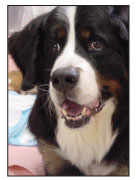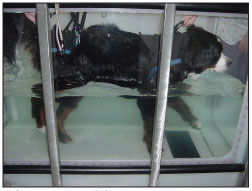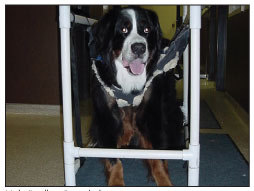
Moki
- BY: Practitioners
By Vicki Kaplan The Woofer Times
The Koch family knew that Moki Bear was the right dog for them. He was a fine specimen of Bernese Mountain Dog. Maybe a little big for his breed, the puppy had a beautiful face and a sweet temperament.
Robert Koch recalls, “Our son was ten years old at the time, and we were looking for a dog that was a little laid back. Moki was the quiet one in the litter.”
He had joint problems, which are not uncommon in large dogs, and when Moki was six, he injured himself. Soon their big beautiful dog couldn’t go up and down stairs without pain. It was obvious that his back hurt, he would hold up one paw, and he couldn’t sit up. The vet determined that Moki had disc degeneration and compression in his spine. “Unless we did something,” Robert remembers, “he just wasn’t going to survive.”
Dr. Peter Maguire, neurosurgeon at Berkeley Dog and Cat Hospital, performed a surgery to expand the space in Moki’s neck. But it was clear during the dog’s poor recovery that the additional space had actually created more instability. According to Dr. Maguire, “Moki got worse instead of better.”
Another surgery had to be performed, one that was technically challenging for the surgeon and much more dangerous to Moki. Metal pins were driven into the animal’s vertebrae, just millimeters from his spinal cord. This was a newly developed procedure and there was no room for error.
That surgery was deemed a success, and Moki should have been able to function. But he wasn’t. He still couldn’t stand; he couldn’t put any weight on his legs. The situation was emotionally devastating for the Kochs. This 100-pound dog that used to run joyfully on the beach now had to be carried. And it took three people to do it.
Joni Kamlet, a veterinary nurse who was training at Berkeley Dog and Cat at the time, says, “He could barely lift his head up. He was a beautiful dog, very sweet, but as low as a dog could be. His limbs were not moving. We had to move him from side to side, had to put him in a cart and roll him out to void. It was heartbreaking to think he was going to be euthanized.”
The Koch family knew they couldn’t keep Moki unless he could get up and down the stairs on his own. They’d heard about canine rehab, but physical therapy was still very rare for dogs. And considering the surgeries and medicines, not to mention the family’s pain, this had already been a very costly few months.
The family had to make a decision that so many dog owners face. Robert said, “Every step along the way, you think to yourself, ‘Are we prolonging his misery? Are we throwing away money? Is this crazy?’” They decided to try to save Moki and rehab was the next step.
There were only two canine rehabilitation facilities in the Bay Area at the time, and the family chose The Canine Rehabilitation Center in Walnut Creek. Dr. Erin Troy assessed the animal and remembers the case well. “Moki was neurologically intact, but he hadn’t walked in over four weeks. I didn’t know how far we’d be able to bring him back, what his quality of life would ever be. But Moki wanted to walk in the worst way.”
After extensive evaluation to make sure Moki wasn’t in pain, that his muscles could function, and that the therapy wouldn’t be a danger to him, the real work began. Every morning started with a warm-up. Massage and passive range of motion exercises were performed, and the nursing staff rolled him from one side to another. The dog was housetrained and it was important to maintain that training. The staff quickly learned to read his cues. Moki had a special bark that said, “I’ve got to go!”
Swimming (hydrotherapy for dogs) – or, more accurately, walking in water – was an important part of Moki’s rehab program. This wasn’t as much fun as it sounds. It took three people and a specially designed support device to place him into a tub with a treadmill floor. Warm, soothing water was then added until Moki was slightly buoyant and his feet rested on the top of the treadmill. That first day in the tank raised everyone’s hopes. His legs moved as soon as the treadmill began. It meant that Moki had motor control.
Some days Moki played Theraball. With his feet touching the ground and his body stretched over a peanut-shaped ball, therapists shifted his weight – left, right, back, and forth. This treatment stretched his back and reeducated the dog’s brain about balance.
There were days when the struggling animal was attached to a cart, like a box on wheels that carried the dog’s weight but allowed him to move forward on his own.
Sometimes Moki wanted to give up. He was confused and didn’t always understand what was expected of him. Dr Troy says, “This was a proud dog. Sometimes he would get stubborn when we were going to make him work. Sometimes we had to use ‘tough love.’ He didn’t like the cart. We’d have to put the cookies far away, so he’d have to work to get them.”
Throughout the therapy, professionals worked to keep Moki’s spirits up. The dog needed to bond with his therapists, to feel confidence and trust in these humans who were putting him through such difficult and strange activities. Every small step was encouraged with the sound of a human voice and rewarded with affection. In the afternoons, Moki was reminded of the good things in life. He was groomed, given toys, and had visits from his family, other patients, and staff dogs.
After a few weeks, there was only a small improvement and the family was again faced with the possibility of putting the dog down. A strong believer in homeopathic medicine, Robert decided to try one more thing. As a last resort, Moki was prescribed a strong homeopathic spinal cord remedy. It wasn’t something the mainstream vets were likely to recommend, but Robert felt there was nothing to lose.
One day it happened. Moki’s legs actually held him up. It took a moment for the fact to sink in, then excitement and euphoria filled the room. Despite all the hours of therapy and hard work, it felt like a miracle. Moki could stand. He could crawl and he could rise to a seated position. Now everyone knew he would be able to walk again. There was no way to predict how far he would walk someday, or how well, but they knew he would walk.
“There is something about Moki,” Robert says. Dr. Troy and her team felt it, too. “Everybody he comes in contact with loves him. He’s like a magnet.”
Once Moki started walking, his recovery progressed quickly, and he continues to exceed everyone’s expectations. What made it possible? The vet who made the diagnosis and the neurosurgeon who performed the delicate procedure played important roles of course. There is no doubt that the efforts of Dr. Troy and her staff, the physical therapy, and the hours of support and encouragement Moki received in rehab were essential. And Robert is sure that Moki’s rate of improvement escalated as a direct result of the homeopathic remedy.
But most of all, it was the love and commitment of one family, a family that never gave up and wasn’t ready to say good-bye when the canine member of their clan needed them most.
Or maybe the miracle was Moki Bear. Want to meet him? Every Sunday, you can find him running on the beach at Crissy Field.


